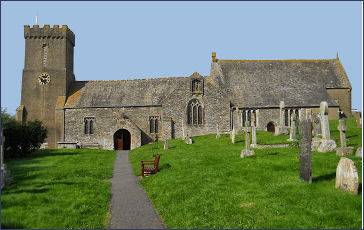Crantock
OS Grid ref:- SW7960
The village of Crantock, known in Cornish as Lanngorrek, is an ancient settlement dating back to 460 AD, when a group of Irish hermits founded an oratory on the site of the village. Crantock is situated near the popular resort of Newquay, from which it is separated by the estuary of the River Gannel.
Once known as Langurroc (which translates as - 'The Dwelling of Monks'), the older part of Crantock huddles around its church, which is dedicated to St Carantoc, founder of the village. Next door to the church stands the ancient thatched Old Albion Inn, notorious as a centre for smuggling, which serves excellent home cooked meals and snacks.
The Round Garden occupies the site of one of the seven Celtic chapels that would have surrounded the original church, now an orchard, it is owned by the National Trust. Nearby stands the village well, Crantock has several thatched cottages, art and craft shops, a tea garden and restaurant. The village hall has recently undergone a transformation, undertaken with money from the National Lottery.
 The
characterful village pub, the Old Albion Inn is around 400 years old.
An entrance to a smugglers hole which passes under the village and is now blocked in for safety�s sake, can be
seen under the blue stone fireplace in the lounge of the inn, originally the kitchen. Until a few years ago the
house drew its water from a deep well under the old bar.
The
characterful village pub, the Old Albion Inn is around 400 years old.
An entrance to a smugglers hole which passes under the village and is now blocked in for safety�s sake, can be
seen under the blue stone fireplace in the lounge of the inn, originally the kitchen. Until a few years ago the
house drew its water from a deep well under the old bar.
Crantock Beach, which is backed by sand dunes, is a popular for surfing location. The beach forms part of the expanse of sand between Pentire and West Pentire headlands, there are cliffs at its southern end. Car parks are provided at Crantock Beach and West Pentire, there is a beach kiosk serving refreshments and lifeguards patrol during the summer months. A small cave on the beach features interesting carvings and verse attributed to a local artist of nearly a century ago.
The coastal footpath skirts all along the west side of the vilage. Large parts of the parish are now owned and cared for by the National Trust, including West Pentire headland which is a Site of Special Scientific Interest and is noted for its colourful range of wild flowers and rare plants. The Coastal path leads to a sandy cove called Porth Joke, which is known locally as Polly Joke. Its name derives from the old Cornish for 'Jackdaw Cove', 'Pol-Lejouack.
In the summer months the village hosts the Crantock summer fiesta, a street fair, which has a coconut shy, tombola, raffle, and many other stalls.
St. Carantoc's Church
 The church of St. Carantoc at Crantock dates back to the early thirteenth century and
occupies the site of an earlier sixth century church. The present church was founded by Bishop Bruerne of
Exeter.
The church of St. Carantoc at Crantock dates back to the early thirteenth century and
occupies the site of an earlier sixth century church. The present church was founded by Bishop Bruerne of
Exeter.
The church tower collapsed in 1412 and had to be rebuilt. Once a major centre of religious administration and learning in Cornwall, the college was closed following the Dissolution of the Monasteries under Henry VIII. The roofs and windows were restored in the eighteenth century, followed by further restorations in the late nineteenth and early twentieth centuries.
St. Carnatoc's font dates back to the twelfth century and the church still retains some Norman features. The church also contains a silver chalice dated 1576. The history of St Carantoc is told in the stained glass windows. The son of a Welsh chieftain, St Carantoc travelled to Ireland where he met with St. Patrick, with whom he studied. Leaving Patrick, Carantoc came to Cornwall in his coracle in which legend relates he brought an altar stone and a pet dove and he came to rest in the Gannel estuary. The dove picked up a stick in its beak, and upon the spot where it dropped the stick he founded his oratory on the site of the present church.
The churchyard contains a medieval stone coffin, a granite cross dating from the nineteenth century which is set on a granite base probably dating to before the Norman Conquest, the stocks are seventeenth century, but the roofed structure that covers them is twentieth century.
A walk from Newquay to Crantock
Distance 4 miles
Duration around 2 hours
*Leave Newquay along Crantock Street, cross Tower Road, continue along Atlantic Road and descend Trethellan Hill signposted to the Gannel.
*Cross the plank bridge and at the field by Penpol Creek follow the path left to a gate into a wood. Continue to a further gate into a sloping field and proceed to gate on the left of Penpol House which leads to the lane to Crantock.
*Leave Crantock village via Beach Road, take the path indicated on the right through a gate and follow it through bushes and fields to the steps down to the pedestrian bridge back to Newquay.